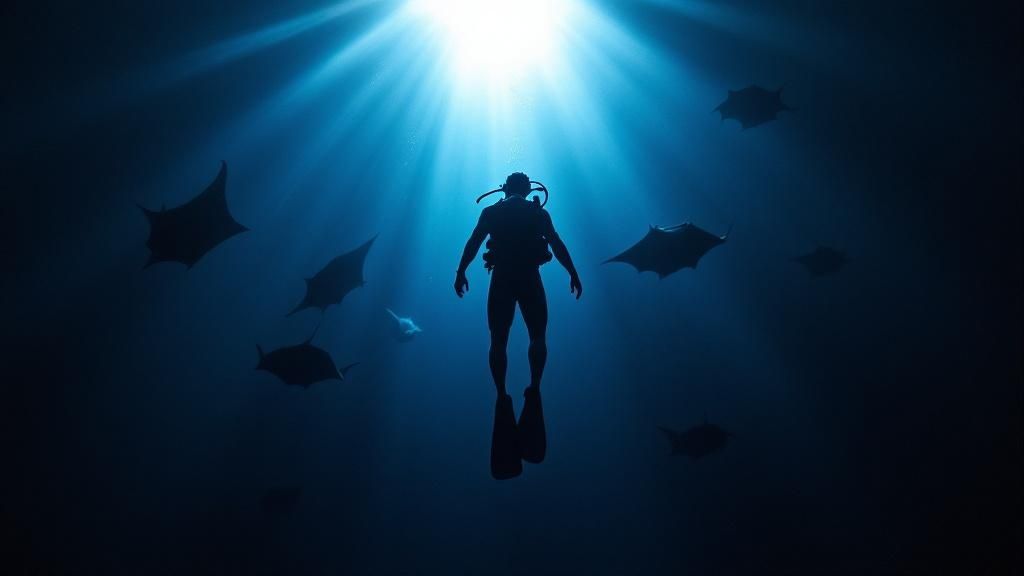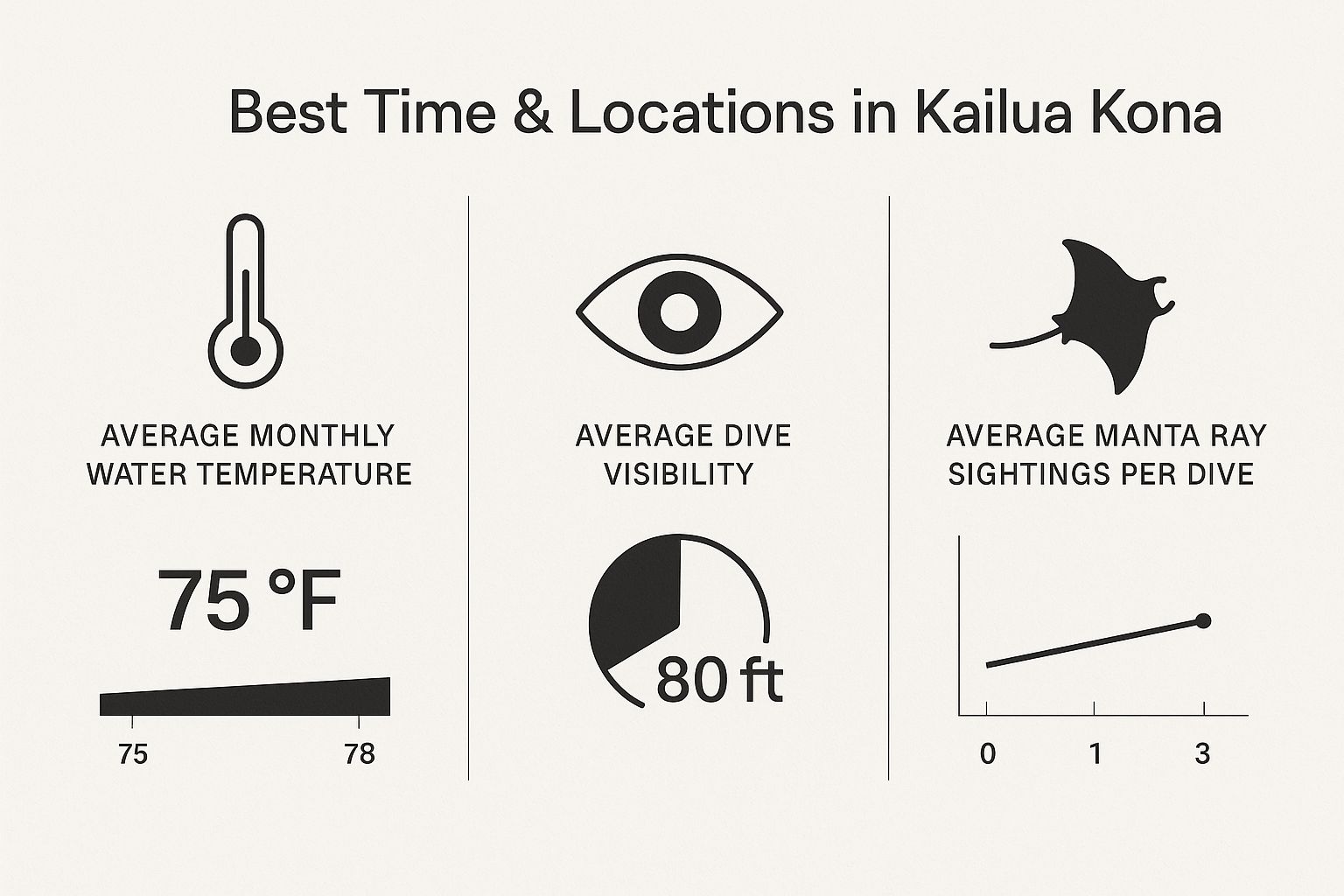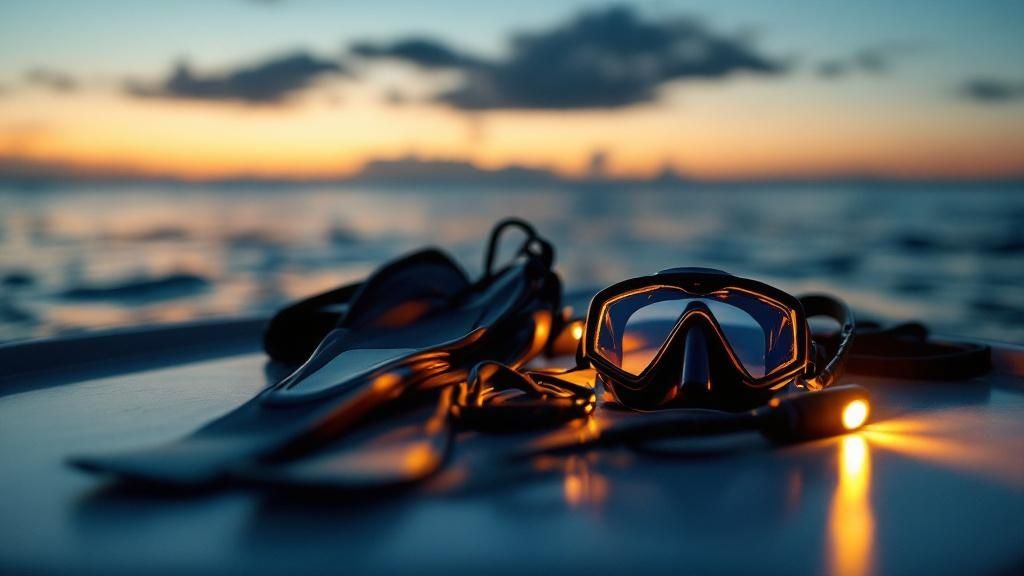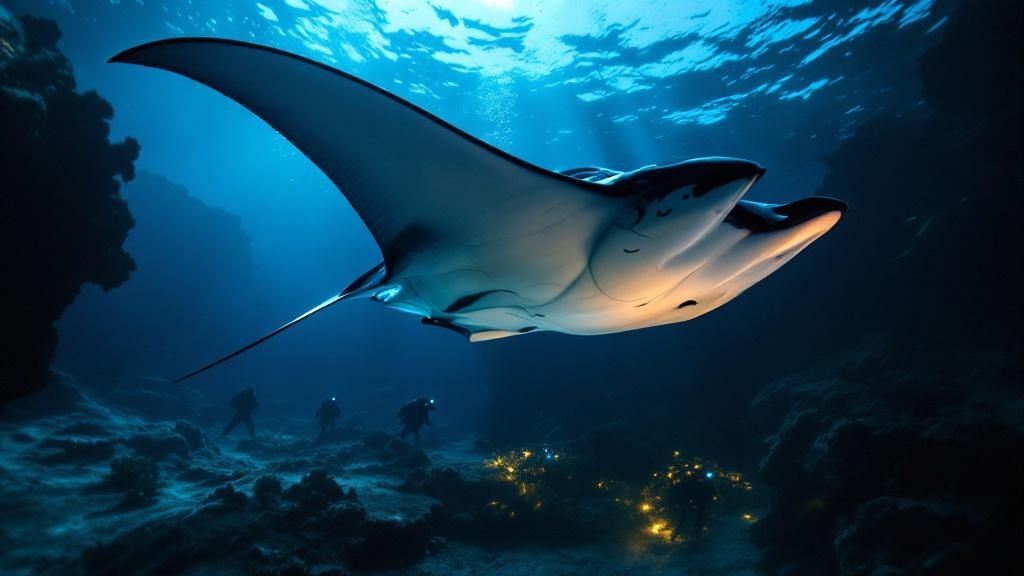Understanding The Magic Behind Manta Ray Night Diving

Imagine a deep ocean ballet, performed in the dark, with manta rays as the stars. Their wingspans, wider than a car, glide through the inky blackness, illuminated by your dive light. This is the magic of a manta ray night dive in Kailua-Kona. It's not just seeing these creatures; it's experiencing a unique ecological performance.
Kona offers almost guaranteed sightings thanks to a special combination of factors. The volcanic seabed creates protected bays rich in nutrients. Steady water temperatures provide a stable home for plankton, the manta rays' main food source. And the plankton-rich currents flowing along the Kona coast deliver a constant feast for these gentle giants.
The Kona Coast: A Plankton Buffet
The key to this nightly spectacle? Plankton. These microscopic organisms are like the popcorn that draws the main attraction to the theater. They thrive in Kona's nutrient-rich waters. The volcanic slopes and constant currents create a perfect plankton breeding ground, essentially an all-you-can-eat buffet for the manta rays. This translates to incredibly high sighting rates. Divers and snorkelers typically see manta rays on 85-90% of guided tours. Discover more insights.
The Role of Light in the Manta Ray Ballet
Now, introduce light to this underwater feast. Dive lights, acting as spotlights, make the plankton even more visible, attracting the manta rays closer. This isn't a random encounter; it's a precisely timed feeding frenzy. Interested in learning more about manta ray dives in Kona? The manta rays use their cephalic fins like scoops to gather the plankton, creating an incredible display for divers and snorkelers.
The predictability of manta ray sightings in Kona sets it apart. While seeing these creatures elsewhere is often a matter of luck, the unique ecosystem and consistent feeding patterns in Kona make this experience almost a sure thing. It's a truly unforgettable adventure.
Choosing Your Perfect Dive Site And Experience Level
Not all manta ray encounters are the same. Choosing the right dive site and experience level in Kailua-Kona can significantly impact your adventure. It’s kind of like choosing seats at a concert. Up close is intense, while further back gives you a broader view. Both are great, but the best one depends on you.
Kailua-Kona's Top Manta Ray Dive Sites
Kailua-Kona has several amazing dive sites, each with its own personality:
-
Manta Village (Garden Eel Cove): Often called "Manta Heaven," this site is famous for its shallow, sandy bottom—perfect for beginners and snorkelers. The high concentration of plankton means there's a constant food source for the manta rays, so you’ll have excellent viewing opportunities.
-
Manta Heaven (Keauhou Bay): South of Kona, this spot is known for potentially larger groups of manta rays. The water's a bit deeper here, and currents can be stronger, so it’s better for experienced snorkelers and divers.
-
Kohala Coast (near Waikoloa): If you prefer a smaller crowd and a more intimate encounter, head north. While you might not see as many manta rays here as at other sites, the tranquility and personalized experience can be truly special.
To help you decide, here's a quick comparison of the main dive sites:
| Site Name | Depth Range | Skill Level | Best Conditions | Unique Features |
|---|---|---|---|---|
| Manta Village (Garden Eel Cove) | Shallow | Beginner | Calm waters | High plankton concentration, ideal for snorkeling |
| Manta Heaven (Keauhou Bay) | Moderate | Intermediate | Calm to moderate currents | Potential for larger manta ray aggregations |
| Kohala Coast (near Waikoloa) | Moderate | Intermediate | Calm waters | Fewer crowds, more intimate experience |
This table highlights the key differences between the sites, allowing you to choose the one best suited to your experience and what you're looking for in a manta ray encounter. As you can see, each site offers a unique experience, so consider your comfort level in the water and your desire for a larger or smaller group.
Snorkeling vs. Scuba Diving: Which Is Right For You?
Deciding between snorkeling and scuba diving comes down to your comfort in the water and your certifications. Snorkeling lets you float on the surface and watch the manta rays glide below you. It’s ideal if you prefer a less immersive experience and don't have scuba certification. Scuba diving, however, takes you down to the ocean floor, giving you a closer, more up-close-and-personal view as the mantas feed above. This requires certification and a higher comfort level in deeper water.

This infographic provides a visual guide to the best times and places for manta ray night dives in Kailua-Kona. It compares average monthly water temperatures, visibility, and how many manta rays are typically sighted on a dive. Manta rays are present year-round, but visibility and water temperature change throughout the year. Knowing this helps you pick the best time for your dive, balancing comfortable conditions with the best chances of seeing these gentle giants. You can learn more about the optimal time of year here: exploring the best time of year to see manta rays in Kona.
Choosing A Reputable Tour Operator
No matter which site or experience level you choose, picking a reputable tour operator is essential. Look for operators with experienced guides, small group sizes, and a solid commitment to responsible diving practices. Their experience and focus on safety will make your manta ray encounter unforgettable and respectful of the animals and their environment.
Preparing For Your Underwater Night Adventure

Imagine stepping into the inky blackness of the ocean, a world unseen by the sun. That's the thrill of a manta ray night dive in Kailua-Kona. But like any grand adventure, preparation is key. Think of it as getting ready for a nighttime hike in unfamiliar terrain – you want to be equipped and comfortable to truly savor the journey.
Essential Gear: Your Underwater Toolkit
Just as a hiker needs sturdy boots and a good map, a night diver needs the right tools. These go beyond the standard snorkeling or diving equipment.
- Wetsuit: While Hawaii evokes images of sun-drenched beaches, the ocean cools down after sunset. A 3mm or 5mm wetsuit acts like a warm hug, keeping you cozy throughout your dive.
- Dive Light: Your dive light is your magic wand, the key to attracting the plankton that, in turn, bring the manta rays closer. Think of it as a miniature underwater campfire, drawing in these gentle giants. Some operators provide lights, but having your own gives you control over the beam and brightness.
- Flotation Device (Snorkeling): If you’re snorkeling, a flotation device like a pool noodle or board isn't just for staying afloat. It becomes a stable platform for your dive light, enhancing its plankton-attracting "bonfire" effect.
Mental Preparation: From Anxiety to Excitement
That first step into the dark ocean can be a bit like stepping onto a stage – a mix of nerves and excitement. It's perfectly normal to feel a little apprehensive, especially if it's your first night dive.
- Pre-Dive Routine: Create a pre-dive ritual to calm your mind, much like an athlete preparing for a competition. Visualize the dive, practice deep breathing, and review safety procedures. This helps transform anxiety into focused anticipation.
- Focus on Breathing: Your breath is your anchor in the underwater world. Slow, deep breaths help regulate your heart rate and create a sense of calm. If you're scuba diving, it also helps conserve your air supply.
- Embrace the Darkness: Don’t fear the dark; embrace it. The ocean at night reveals a hidden world, teeming with bioluminescent creatures and the ethereal dance of the manta rays. It's like entering a secret, magical realm.
Physical Preparation: Ensuring a Smooth Dive
Being physically prepared is more than just being a strong swimmer. It's about ensuring your body is primed for this unique experience.
- Hydration: Proper hydration is essential for any dive, but especially at night. Dehydration can amplify anxiety and impair your physical performance, so drink plenty of water in the hours leading up to your dive.
- Rest: A good night’s sleep before your dive is like charging your batteries. It improves alertness and reaction time, making your experience safer and more enjoyable.
- Check Your Certifications: If you're scuba diving, make sure your certification is current. If you're not certified and want to explore the depths with scuba gear, consider a certification course like the Kona Scuba Certification Course.
By focusing on these elements – gear, mental preparation, and physical readiness – you'll transform pre-dive jitters into confident excitement. You’ll be ready to not just observe, but fully participate in the breathtaking ballet of manta rays under the Kona night sky.
The Science Of Light, Plankton, and Feeding Behavior

Think of a spotlight on a stage. It doesn't just illuminate the dancer; it creates the space for the performance. Similarly, dive lights on a manta ray night dive in Kailua-Kona aren't simply for seeing; they set the stage for a remarkable display of nature. These lights, carefully positioned, mimic the moon and stars, attracting the manta ray's favorite food: plankton.
The Plankton Connection
Manta rays, despite their impressive size, dine on microscopic organisms. Plankton, a diverse collection of tiny plants and animals, drift with the currents, forming the base of the ocean's food web. Just as a porch light attracts moths, the animal part of plankton (called zooplankton) is drawn to light in the water. This attraction is a deep-seated part of their evolutionary history.
The "Bonfire" Effect and Feeding Frenzy
Dive lights during a manta ray night dive create what's known as a "bonfire" effect. This concentrated light attracts huge amounts of plankton, bringing in the manta rays for a feeding frenzy. Learn more about the manta ray dive in Kona. The strategic use of light is also why these dives are available year-round. Both snorkelers and scuba divers use lights, attracting plankton, which in turn brings the manta rays close. Learn more about manta ray night dives here. The mantas, with their cephalic fins (those horn-like extensions on their heads) gracefully channel the plankton-rich water into their mouths, creating an unforgettable sight.
Seasonal Variations and Operator Expertise
Manta rays are found in Kona throughout the year, but the amount of plankton changes with the seasons. Experienced tour operators understand these shifts. They collaborate with marine researchers, adjusting lighting techniques and dive locations to optimize your chances of seeing these magnificent creatures. This partnership ensures a respectful approach that honors the natural rhythms of the ocean.
From Passive Observation to Active Participation
Understanding the connection between light, plankton, and manta ray feeding behavior transforms a night dive into something truly special. You’re not just watching; you're part of a delicate ecological dance. You're witnessing the interconnectedness of marine life firsthand. This knowledge adds a layer of appreciation and wonder to an already amazing experience.
Safety Protocols And Responsible Diving Practices
We’ve talked about how manta rays feed; now let's explore how to ensure a safe and respectful encounter during a manta ray night dive in Kailua-Kona. Imagine you're visiting a darkened art gallery filled with delicate masterpieces. You need guidelines to appreciate the beauty without causing any damage.
Protecting Yourself And The Rays
Reputable dive operators, like Kona Honu Divers, place a high priority on safety and have established protocols for these unique night dives. These aren’t arbitrary rules, but carefully developed practices based on years of experience.
-
The Buddy System: Just as with daytime diving, staying with your buddy is essential, especially in low visibility. Maintain visual contact and agree on hand signals before you enter the water.
-
Emergency Communication: Dive operators will have specific emergency procedures and communication methods. Review these beforehand so you know what to do if a situation arises.
Respectful Manta Ray Interactions: The Do's And Don'ts
Interacting with manta rays is a privilege, not a right. Think of yourself as a guest in their underwater home. You want to leave a good impression.
-
Positioning: Finding the right spot is key to a comfortable experience for both you and the rays. Stay a respectful distance, never obstruct their path, and absolutely never attempt to touch or ride them. Touching a manta ray can damage its protective mucus layer, making it susceptible to infection.
-
Reading Body Language: Manta rays communicate through subtle movements. Learn to recognize signs of stress or simple curiosity. A ray moving away is asking for space. Barrel rolls and backflips are feeding behaviors, not invitations to interact.
-
Maintaining Respectful Distances: Always give manta rays plenty of room. A safe distance is at least 10 feet. This allows them to feed undisturbed and minimizes the risk of accidental contact.
Common Mistakes And How to Avoid Them
Even seasoned divers can make errors in the excitement of the moment. Knowing the pitfalls helps everyone have a positive experience.
-
Chasing Manta Rays: It’s tempting, but don't do it. Chasing stresses the rays and disrupts their feeding. Let them come to you.
-
Crowding the Feeding Area: Too many divers in one spot can overwhelm the manta rays. Be mindful of other divers and follow your guide’s instructions for the best viewing locations.
-
Touching the Manta Rays: It bears repeating: never touch a manta ray, no matter how curious it seems. It can damage their delicate skin and expose them to harmful bacteria.
By following these safety protocols and practicing responsible diving, you protect not only yourself but also these magnificent creatures. Your mindful participation helps ensure the long-term health of the manta ray population and the continued enjoyment of these incredible night dives in Kailua-Kona for years to come.
Maximizing Your Encounter Through Smart Observation
Capturing the magic of a manta ray night dive in Kailua-Kona isn't just about having the fanciest equipment. It's about understanding these graceful creatures, timing your shots, and positioning yourself strategically. Whether you're using a simple waterproof camera or a professional rig, these tips will help you create unforgettable memories while prioritizing safety. For general snorkeling safety guidelines, take a look at these snorkeling safety tips.
Understanding Manta Ray Behavior
Manta rays, despite their impressive size, are gentle giants of the ocean. They aren't aggressive and their diet consists primarily of tiny plankton. Understanding their feeding habits is the key to getting those incredible shots. Manta rays are drawn to light, which attracts the plankton they feed on. Think of the dive lights as creating a "plankton bonfire," concentrating their food source and bringing the mantas in for a feast. During this feeding frenzy, they often perform dramatic barrel rolls and backflips, creating amazing photographic opportunities.
Timing Is Everything
The best time to capture stunning images is during these feeding frenzies. Try to anticipate their movements and be ready to snap a photo or start filming as they glide through the illuminated water. Patience is essential. Sometimes, the manta rays will swim directly overhead, offering breathtaking close-up views. Other times, they'll circle at a distance, allowing you to capture wider shots that showcase their impressive size and graceful movements.
Positioning for the Perfect Shot
Positioning is crucial for both observation and photography. Remember, respecting the manta rays’ space and avoiding disrupting their natural behavior is paramount.
- For Divers: Stay on the ocean floor and avoid getting in the manta rays' way. Position yourself slightly to the side of the main light beam for the best visibility and photo opportunities.
- For Snorkelers: Hold onto your flotation device and resist the urge to dive down into the water column where the mantas are feeding. Keep your movements slow and controlled.
Lighting Techniques for Night Photography
Capturing clear images in the dark requires a little know-how with your dive light.
- Avoid Direct Flash: Flash photography can startle the manta rays and interrupt their feeding.
- Use Ambient Light: Rely on the dive lights provided by the tour operator and your own dive light to illuminate the scene. Adjust your camera settings to best capture this ambient light.
To help you capture the magic of these gentle giants, here's a handy guide for your underwater photography setup:
Underwater Photography Equipment Guide
Essential camera equipment and settings for capturing manta rays during night dives
| Equipment Type | Recommended Models | Key Settings | Price Range | Skill Level |
|---|---|---|---|---|
| Action Camera | GoPro HERO11 Black, DJI Osmo Action 3 | High ISO, Wide Aperture, 4K Video | $350 – $500 | Beginner – Intermediate |
| Compact Underwater Camera | Olympus Tough TG-6, SeaLife Micro 3.0 | Underwater Mode, Macro Mode | $400 – $800 | Beginner – Intermediate |
| Mirrorless/DSLR with Underwater Housing | Sony a7 IV, Canon EOS R5 with dedicated housings | Manual Mode, Adjust ISO and Aperture based on conditions | $1500+ (camera + housing) | Intermediate – Advanced |
| Dive Lights | Bigblue AL1200NP Pro, Orcatorch D950V | Spot or Flood Beam | $200 – $600 | All Levels |
This table offers a quick look at recommended equipment for various skill levels and budgets, along with key settings to consider. Remember, even a basic setup can capture amazing footage with the right techniques.
Respectful Observation Practices
The primary goal is to observe and document these magnificent creatures without interfering with their natural behavior. Avoid chasing the manta rays or trying to touch them. Maintaining a respectful distance allows them to feed undisturbed and ensures a sustainable and enriching experience for all.
By understanding these simple principles, you can maximize your manta ray night dive experience in Kailua-Kona and create memories that will last a lifetime. Whether you're a seasoned underwater photographer or just want to capture the wonder for yourself, these techniques will help you preserve the magic of this unique encounter.
Planning Your Kailua-Kona Manta Ray Adventure
Planning a manta ray night dive in Kailua-Kona is a bit like planning a special night out. You wouldn't just show up at a concert without tickets, right? The same goes for this incredible experience. A little preparation transforms a good dive into a truly unforgettable one.
Choosing the Right Tour Operator
Your tour operator is your guide to the underwater world, like a knowledgeable concert usher leading you to the best seats. Choosing a reputable one is key. Look for operators who emphasize sustainable practices and keep their group sizes small. Smaller groups mean more personalized attention from the guide and less disruption to the manta rays' natural environment. Don't hesitate to ask about the guide's experience and the company's commitment to conservation. The best operators prioritize the well-being of the mantas and the quality of your experience.
Timing Your Adventure
Manta ray night dives in Kailua-Kona are a remarkable year-round activity, drawing visitors from across the globe. Unlike many wildlife encounters limited to specific seasons, these dives are available 365 days a year, making Kailua-Kona a reliable hub for this type of tourism. Discover more insights about manta ray night dives. While sightings are common throughout the year, certain periods might offer slightly more favorable viewing conditions. Summer (June-August) typically brings calmer seas and improved visibility. However, every season offers a unique perspective, and experienced operators know how to adapt to the changing conditions.
Booking Strategies and Backup Plans
Like scoring tickets to a sold-out show, booking your dive ahead of time is a good idea, especially during busy travel periods. Booking early in your trip allows for more flexibility. Some operators even offer a "manta guarantee," giving you a free second chance to dive if mantas aren't spotted on your first try. It's a nice safety net that takes the pressure off.
Understanding Weather and Dive Conditions
Weather is a factor in any ocean activity. Checking the marine forecast before you dive is essential. While Kona generally boasts pleasant weather, occasional storms or strong currents can impact visibility and overall dive conditions. Having a backup plan, such as exploring local attractions on land, is always wise.
Post-Dive Celebrations
After your magical encounter with the manta rays, why not celebrate? Kailua-Kona offers a variety of post-dive dining options, from relaxed beachfront spots to more formal restaurants. Sharing your photos and stories with fellow divers solidifies the shared experience and creates lasting memories. It's also a great opportunity to learn more about these gentle giants and the important conservation efforts that protect them.
By planning carefully, you can transform your manta ray night dive into an experience that surpasses your expectations. Every detail matters, from selecting a responsible tour operator to embracing the unexpected, adding to the magic of this unique encounter.
Beyond The Dive: Conservation And Community Impact
Your manta ray night dive in Kailua-Kona is more than a personal thrill. It's a direct contribution to a conservation success story. It's like buying a ticket to a concert where the proceeds go directly to supporting the band and their future music. In this case, your dive supports research, protects vital habitat, and rewards those working hard to protect the ocean.
Manta Ray Tourism: A Model For Sustainable Wildlife Encounters
Responsible manta ray tourism is setting a global standard for sustainable wildlife interactions. The money it generates funds vital research. Think of each dive operator as a research vessel, gathering information with every trip. These programs track individual manta rays (using their unique belly markings, much like fingerprints), check on the health of the population, and shape policies that protect these gentle giants. For a deeper dive into planning your trip, check out this detailed blog post about Kona Manta Ray Night Snorkel.
How Your Photos Contribute To Science
Even your vacation photos can contribute to scientific understanding. Identification programs use pictures taken by divers and snorkelers to build scientific databases. Imagine, your snapshots helping researchers map manta ray migration and understand how their numbers change over time. Around 80,000 people join snorkeling and diving tours annually to see manta rays, adding substantially to local tourism. This tourism not only boosts the local economy but also provides a unique platform for education and conservation. Discover more insights.
Community Impact: Ripples Beyond The Reef
The positive impact of manta ray tourism spreads throughout the community. Your spending supports local businesses, creates jobs, and funds community projects focused on ocean health. Think of it like dropping a pebble in a still pond – the ripples spread outwards. In this case, the ripples represent thriving local economies and a growing awareness of our marine ecosystems. Read also: Manta Rays Night Dive Kona Honu Divers.
Ensuring Encounters For Future Generations
Thanks to ongoing research and dedicated local conservationists, your participation helps ensure these magical experiences remain possible for generations to come. You're not just a spectator; you're part of a larger solution, contributing to broader ocean conservation efforts that extend far beyond Hawaii. It's a delicate dance between allowing access and providing protection, and your mindful participation truly matters.
Experience the wonder of a manta ray night dive and become part of this important conservation work. Book your unforgettable adventure with Kona Honu Divers today! Dive into the magic with Kona Honu Divers.
